The ICC’s Al-Mahdi ruling protects world heritage, but doesn't go far enough
The International Criminal Court's sentence against Al-Mahdi for destroying ancient artefacts at Timbuktu sends the right message about the importance of cultural heritage, but it misses a valuable opportunity, write Lucas Lixinski and Sarah Williams.


